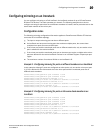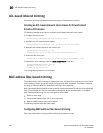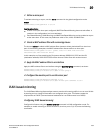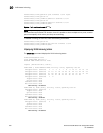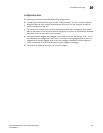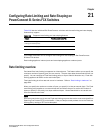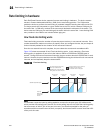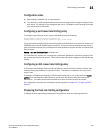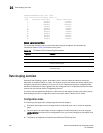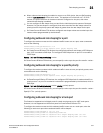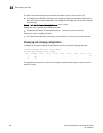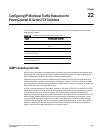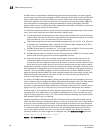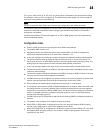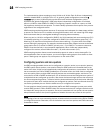
PowerConnect B-Series FCX Configuration Guide 645
53-1002266-01
Rate limiting in hardware
21
Configuration notes
• Rate limiting is available only on inbound ports.
• The rate limit on IPv6 hardware takes several seconds to take effect at higher configured rate
limit values. For example, if the configured rate limit is 750 Mbps, line-rate limiting could take
up to 43 seconds to take effect.
Configuring a port-based rate limiting policy
To configure rate limiting on a port, enter commands such as the following.
PowerConnect(config)#interface ethernet 24
PowerConnect(config-if-e1000-24)#rate input fixed 500000
These commands configure a fixed rate limiting policy that allows port 24 to receive a maximum of
500000 bits per second (62500 bytes per second). If the port receives additional bytes during a
given one-second interval, the port drops all inbound packets on the port until the next one-second
interval starts.
Syntax: [no] rate-limit input fixed <average-rate>
For PowerConnect devices, the <average-rate> parameter specifies the maximum number of bits
per second (bps) the port can receive. The minimum rate that can be configured is 64,000 bits per
second.
Configuring an ACL-based rate limiting policy
IP ACL-based rate limiting of inbound traffic provides the facility to limit the rate for IP traffic that
matches the permit conditions in extended IP ACLs. This feature is available in the Layer 2 and
Layer 3 code.
To configure ACL-based rate limiting on a Dell PowerConnect device, you create individual traffic
policies, then reference the traffic policies in one or more ACL entries (also called clauses or
statements). The traffic policies become effective on ports to which the ACLs are bound.
For configuration procedures for ACL-based rate limiting,refer to Chapter 18, “Configuring Traffic
Policies”.
Displaying the fixed rate limiting configuration
To display the fixed rate limiting configuration on the device, enter the following command.



